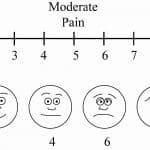Table of Contents
What is joint pain?

Joint pain or arthralgia is a possible side effect of cancer and cancer treatment. However, it can also occur due to causes unrelated to cancer. Joint pain can occur in the hands, feet, knees, hips, shoulders, lower back, spine, and other joint areas.
Joint pain can affect the quality of life and worsen other symptoms or side effects of cancer. In addition, severe joint pain can interfere with cancer treatment causing discontinuation of the treatment.
How bad is my joint pain?
Your clinic team will use this scale (see figure on right) to measure how bad your pain is.

Mild: Pain score of 3 or less on the VAS scale. This pain should not stop you from doing activities of daily life (like grocery shopping, laundry, cooking).
Moderate: Pain score of 4 to 6. This pain stops you from doing instrumental activities of daily life (preparing meals, managing money, shopping, doing housework, and using a telephone).
Severe: Pain score of 7 or higher. This pain is bad enough to stop you from even the most basic (self-care) activities of daily life like eating, dressing, getting into or out of a bed or chair, taking a bath or shower, and using the toilet.
How to manage mild pain?
Keep track of your pain levels using Ankr (myAnkr web portal or the Ankr app). It will help you describe the pain to your doctor or nurse.
- A physical therapist can help restore function in a joint, as well as teach you how to relieve pain using simple exercises or assistive devices.
- Acupuncture can help relieve joint pain related to aromatase inhibitor therapy. Acupuncture involves placing small needles in specific points of the body.
- Stretching and gentle exercise can also help you manage your weight, strengthen your bones and the muscles around your joints, as well as increase joint flexibility.
- Hot or cold compresses, heating pads, or ice packs may help decrease discomfort.
- A massage therapist performs a gentle therapeutic massage that may help ease the pain. You or your caregiver can also do simple massage techniques at home.
How to manage moderate and severe pain?
Talk with your health care team. Relieving side effects is an important part of cancer care and treatment. Make an appointment with your doctor if it is accompanied by swelling, redness, tenderness, and warmth.
What are the causes?
- Some cancer treatments can cause joint pain. Often, the pain goes away after treatment. In some cases, it can be a late effect, which means it occurs months or years after cancer treatment ends.
- Some types of chemotherapy (bleomycin, cladribine, L-asparaginase, and paclitaxel) and taxane-based chemotherapies
- Aromatase inhibitors (anastrozole, exemestane, and letrozole) which are medications to treat certain types of breast cancer.
- Other hormonal therapies (fulvestrant, raloxifene, tamoxifen, and toremifene)
- Some targeted therapies (T-DM1 or ado-trastuzumab emtasine and olaparib)
- Some immunotherapies (CTLA-4 and PD-1/PD-L1 inhibitors)
- Steroid medications
2. Other medications that are given during cancer treatment:
- White blood cell growth factors (filgrastim, pegfilgrastim, and sargramostim) that help prevent infection during cancer.
- Biophosphonates, which are used to treat bone loss.
- Certain pain medications
3. Other factors. People with cancer can also have joint pain from another medical condition (rheumatoid arthritis, osteoarthritis, fibromyalgia, lupus, gout, bursitis, and tendinitis) that are unrelated to cancer.
4. An infection in the joint can also cause pain.
